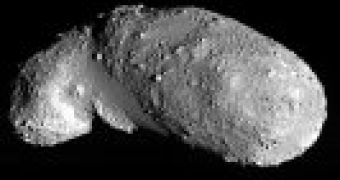Asteroid Itokawa repeatedly shakes the booty; that's what the tiny pebbles on the near-Earth cosmic object show. Like a jiggled jar of mixed nuts, shaking on the near-Earth asteroid is sorting loose rock particles on its surface by size, causing the smallest grains to sink into depressions, a new study suggests.
Researchers analyzed images of a mix of boulders and gravel, called regolith, covering the surface of Itokawa. The images, taken by the Japanese Hayabusa spacecraft in 2005, revealed that some areas were coated with fine particles and appeared smooth, while other regions looked bumpy, as if the asteroid suffered an intense case of acne. Hayabusa space probe touched down on the asteroid twice in November 2005 and now researchers are awaiting its return to hopefully analyze the rock samples it collected.
In a study, researchers suggest the regolith's patchy distribution is the result of shaking, which causes the finest and lightest materials to accumulate in dips on the asteroid's surface, where the local gravity is lowest.
Researchers report that millimeter- to pea-size rocks have pooled in three troughs on the asteroid's surface, suggesting that the grains flowed downhill like potato chip crumbs falling to the bottom of the bag. Although the true cause of the pooling is unclear, repeated shaking can make smaller rocks slide by allowing them to work their way around larger ones.
"It's sort of like if you poured water over Itokawa, all the water would tend to pool in these [low] regions," said study team member Daniel Scheeres of the University of Michigan. "The water would flow downhill until it couldn't go downhill anymore."
The new findings suggest seismic activity of some kind is occurring on Itokawa, a small asteroid only 1,600 feet (500 meters) in diameter. Or maybe other effects could be dragging rocks downhill, including variations in the asteroid's gravity as it passed near Earth or during a possible earlier phase in which the asteroid consisted of two pieces orbiting one another. Given its weak gravity, the apparent movement of its rocks is pretty weird.
Studying Itokawa asteroid could reveal some processes that scientists are not aware of on other larger bodies.

 14 DAY TRIAL //
14 DAY TRIAL //